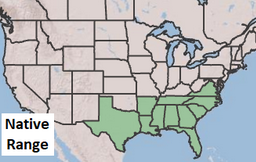Carolina Jasmine
Gelsemium sempervirens
Click here to download a PDF of this plant information page (for printing).

Sun Exposure: Full Sun, Part Sun
Season of Interest: Early Spring
Bloom Time: February - March
Bloom Color: Bright Yellow
Height: 15 to 20 ft.
Spread: 3 to 6 ft.
Spacing: 6 ft.
Water Needs: Average
Maintenance: Prune after spring bloom
Soil Type: Loam, Sandy, Clay
Soil pH: Acidic, Neutral, Alkaline
Soil Drainage: Well drained
Pests: None (Deer resistant)
Diseases: None
Wildlife: Bees, Buterflies, Hummingbirds

Description:
Carolina jasmine is one of the most beautiful vines native to the South. It covers fences and trees in open woodlands and along roadsides throughout the Southeast with its slender vines and bright yellow flowers. It is the state flower of South Carolina. Carolina jasmine grows to 20 feet or more when grown as a vine. It can also be grown as a ground cover, maintained with a yearly cutting in late spring after flowering to 3 feet or less. For more information see:
plants.ces.ncsu.edu/plants/gelsemium-sempervirens
Care and Growing Tips:
This vine’s growth rate is moderate, growing rapidly once established or with rich soil and adequate water. Sweetly scented, golden yellow flowers cover the cascading, fine textured foliage from February to April. The trumpet-shaped blooms have 5 lobes and are attractive to butterflies and hummingbirds. The shiny evergreen leaves are 1 to 3 inches long on 10-to-20-foot vines. Carolina jasmine is easy to grow. It is attractive on an arbor where the slender branches hung with yellow flowers can be seen from below. This plant will stay in scale and can be used on decks and porches and near patios and entryways. It is good in containers and as a ground cover along steep banks to help control erosion.
Carolina jasmine tolerates either full sun or partial shade. Flowering is more prolific and foliage growth is denser in full sun. This vine is very adaptable and will grow in a variety of conditions. For best results, plant it in rich, well-drained soil. Moist soil is ideal, but the vine is able to withstand periods of drought once established. Space plants 3 feet apart as a ground cover, and 4 to 8 feet apart for fence or trellis climbers. Fertilize while the plant is actively growing with moderate amounts of a slow-release, balanced fertilizer, such as a 12-6-6. Do not overfeed, since excessive fertilizer can reduce flowering.
Older vines that become top heavy or sparse can be pruned back to a few feet above ground level after flowering. Remove dead or broken branches and shape the plant each year after bloom. Mow groundcovers every few years to maintain density.